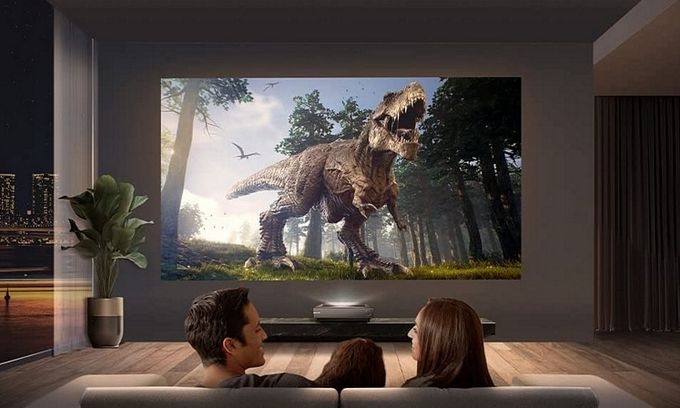The home entertainment segment has been demonstrating unprecedented momentum for decades. But mostly manufacturers preferred TVs and audio systems. Projectors burst onto this list about 5 years ago due to ultra short throw (UST) models.
UST projector
Of course, companies have long offered a wide range of superb Home Theater mid-focus projectors. But placing them in the room center creates a problem with wires on the floor, which is especially inconvenient for families with children or pets. Unfortunately, complex and troublesome ceiling mount is the only way to solve this problem. UST projectors produce a 100-inch or more image a from a 10″ distanced. As a result, placing them against a wall automatically eliminates the problem of wires.
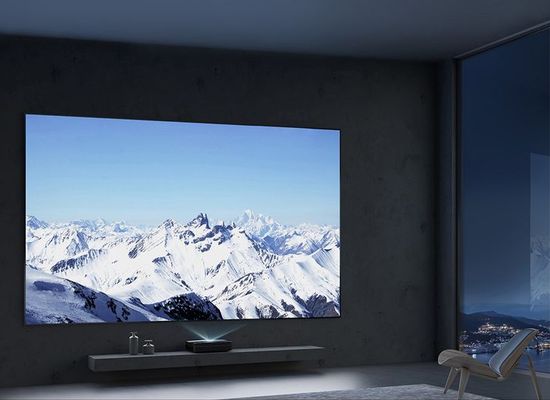
This aspect has become a significant factor in the competition between TVs and projectors. Today, both directions are in a state of dynamic equilibrium. Modern UST projectors with ALPD 3.0-based light engine (laser + phosphor) and 4K resolution (4-phase pixel shift TI DMD with Xpanded Pixel Resolution or XPR technology) are offered starting at $ 2,000. They offer 100″-150″ 4K image, the quality of which is quite high even in diffuse daylight. Moreover, it rises to the level of mid-budget TVs in the evening in the dark. The price of the most popular 65-inch OLED, QD-OLED and QLED miniLED TVs also starts at $ 2,000. Of course, the TV image has a higher quality due to greater brightness, contrast and native 4K resolution, but its size is twice smaller. As a result, more and more consumers are choosing UST projectors as a TV alternative.
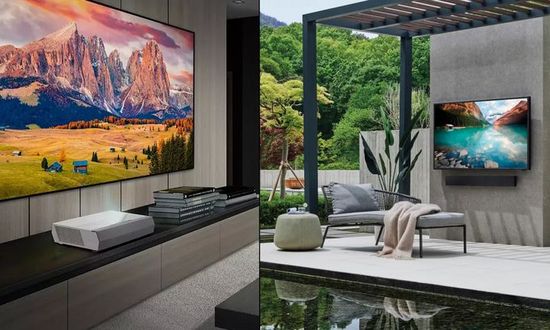
Of course, manufacturers adequately respond to consumer demand by offering a huge number of new UST models. Unfortunately, a wide range sometimes complicates the choice. But an analysis of the main specs, including brightness, resolution, contrast, etc can be helpful in choosing the optimal model.
Brightness
The projector brightness improves HDR performance and compensates for ambient light, reducing dimming requirements. In particular, 3,000 ANSI lm will provide acceptable quality even in diffuse daylight. A portable LED model with a brightness of up to 150 ANSI lm will form a sufficiently high-quality projection only in the dark. Also, the required brightness depends on the screen size. For example, 200 ANSI Lumens will be enough for a 24-inch screen, but a 150-inch projection can be dim and pale even at 2,000 ANSI lm.
The Internet offers a lot of discussion about the screen size choice. But, to be fair, the choice depends on personal preference. In any case, using a projector with a screen less than 80 inches seems counterproductive.
The Society of Motion Picture and Television Engineers (SMPTE) recommends an optimal brightness of 16 foot-lamberts (ftL) for a dark room. In fact, this is a measured brightness of a projector’s output spread over the screen surface. General conversion formula:
ftL = projector lumens ÷ screen area x screen gain. In practice, a brightness of ~600 ANSI lm delivers the recommended 16 ftL on a 110-inch screen in a darkroom.
Due to different measurement methods, companies list the brightness of their models in different units:
– ANSI (American National Standards Institute) lumens.
This most common method measures the luminous flux at nine points on the screen;
– ISO lumens – ISO (International Organization for Standardization) standard, ISO 21118;
– LED lumens characterize the brightness perceived by the eye;
– White Brightness + Color Brightness in Epson models.
3-chip 3LCD technology ensures the identity of White Brightness and CLO (Color Light Output).
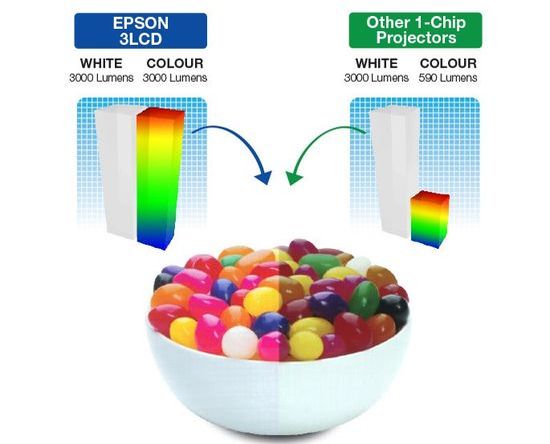
To avoid accusations of inaccuracy, many well-known companies often do not indicate the exact brightness of their models.
Resolution
Without a doubt, pixel-shift or eShift technology can be positioned as one of the revolutionary milestones in the development of projectors. It was first implemented in JVC’ projectors in 2013 to upscale 1080p D-ILA chips. Epson was the next company to use this technology for (1,920 x 1,080) 3LCD chips. Then Texas Instruments introduced an .66″ chip with a (2,716 x 1,528) mirror matrix that uses two-phase pixel shift to create 8.3 million pixels. New 0.47″ DLP 1080p chip creates 8.3 million pixels with four-phase eShift.
TI called this technology Xpanded Pixel Resolution (XPR). In fact, TI DMD (Digital Micromirror Device) with a relatively cheap 1080p chipset and XPR support displays 8 million pixels of 4K content. This technology has created excellent prospects for the development of low cost DLP 4K projectors.
The pixel shift operation principle is simple and captivates with its elegance. The .47″ DLP 1080p chipset (2 million micromirrors) takes 4K content and splits it into four parts of 2 million pixels each. It then sequentially plays 4 separate frames diagonally shifted by half a pixel from each other.
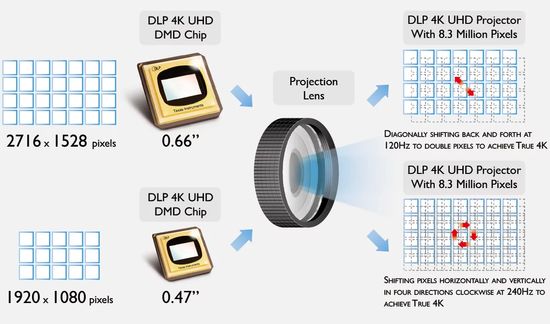
As a result, 2 million micromirrors reproduce 8 million pixels of a 4K image. Strictly speaking, at any given moment, a 1080p projector chipset only displays 2 million pixels on the screen. But our vision and brain do not perceive the micro-delay between their switching, creating the illusion of a holistic image.
Pixel shifting is done by tilting the lens using four electromagnets of XPR module.
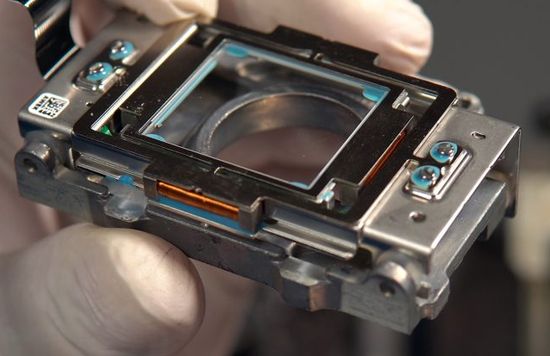
Some experts are skeptical about this technology, calling it ‘faux-4K’. But today, DLP 4K projectors with TI DMD XPR chipsets cost $ 2,000- $ 3,000 and dominate the lower premium segment due to superb value for money.
Contrast ratio
The contrast is the ratio of the white / black and provides detail by displaying subtle shades of colors. It’s measured with full On/Off (FOFO) or ANSI method.
FOFO uses 100 IRE test pattern (‘full on’), and the 0 IRE test pattern (‘full off’) for black. The ANSI uses a checkerboard pattern with eight white and eight black rectangles. The brightness values of all squares are measured and averaged. Then the ANSI contrast ratio is calculated as the ratio of the averaged white/black readings. But the specs include only FOFO. More accurate ANSI method is used only among professionals.
The inaccuracy of FOFO is caused by incorrect measurement on a full black 0 IRE test pattern due to light scatter in the light engine and lens. As a result, these methods give different results.
For reference, FOFO contrast typically ~ 500:1 for LED DLP and ranges from 1,000:1 – 3,000:1 for laser models.
However, companies effectively increase image contrast by adjusting light output by opening/closing the auto iris or turning the laser off/on. In tern, decreasing lumen output darkens black details in a dark scene.
Of course, companies are improving these technologies. For example, BenQ has developed Dual Iris technology with preset contrast ranges for Cinema/Dynamic/Standard/Photo modes. TI DynamicBlack algorithm analyzes the scene and automatically selects the optimal iris depending on the content.
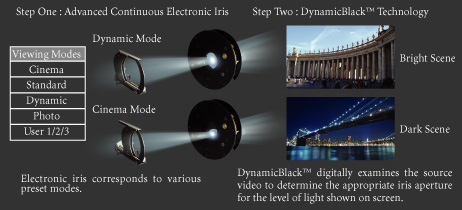
As known, LCoS projectors provide ‘infinite’ contrast due to perfect blacks. Instead of reflection, they transmit light through liquid crystals. In tern, the tiny width of the gaps between the liquid crystals reduces light scattering to min.
Today LCoS has Sony / SXRD (Silicon X-tal Reflective Display), JVC / D-ILA (Digital Direct Drive Image Light Amplifier) and Canon / AISYS (Aspectual Illumination System) versions. But they price starts at $ 5,000.
Bit depth
Almost all companies indicate color bit depth in specs. Some underestimate its informativeness, but it directly affects the color gamut. In turn, it provides rich colors and, ultimately, a colorful image. Technically, bit depth characterizes the projector’s ability to reproduce wide color gamut (WCG) and high dynamic range (HDR) content.

In other words, it corresponds to the max number of shades that the projector can reproduce in a frame. Visually, the increase in bit depth is accompanied by a smoothing the transitions between shades.
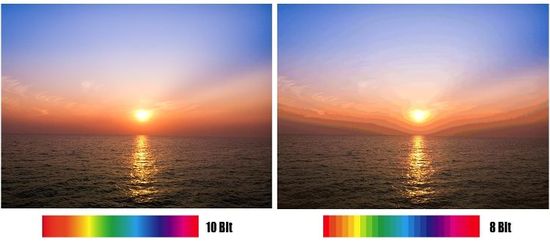
However, our vision well distinguishes the increase in gradations only up to 10 bit. The difference between 10-, 11-, and 12-bits is almost not perceived anymore.
As know, any 3-chip projectors form a color image as follows:
– creation of associated R,G and B grayscale images from incoming data channels;
– backlight by R,G and B colors that are generated with the help of filtering white or using R,G and B LEDs / lasers;
– combining them into a full color image on screen.
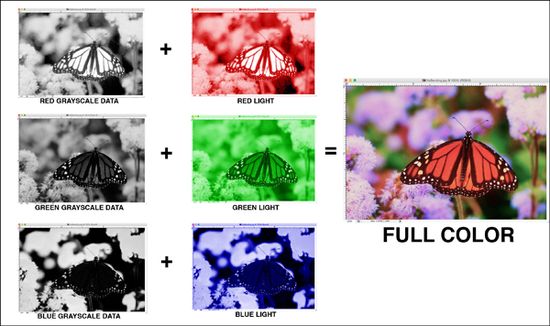
Each additional bit expands the possibility of coding shades, increasing their number.
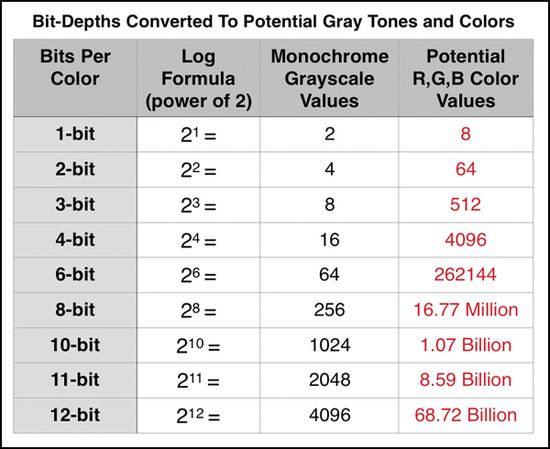
But this aspect has a nuance. Of course, marketing considerations encourage companies to list tens of millions and even a billion shades in specs. But according to vision experts, the human distinguishes around 12 million individual colors. In fairness, only a few women in the world can distinguish up to 100 million colors. This ability arose from the fourth color sensitive cone in their eyes, which was due to a genetic mutation.
Lens shift
Essentially, vertical and horizontal lens shift moves the image left/right and up/down without rotating the projector. Models without this feature offer only keystone correction, which has several cons.
As known, most projectors have keystone correction from ±30 degrees or more. But it lowers image brightness. In fact, this function matches the pixels of an image and uses only part of the imaging chip to form an image with 90 degree angles. Accordingly, the luminous flux in the unused area is partially lost.
Also, matching the native resolution of the projector with the content provides the one-to-one match between their pixels. Incomplete use of the chipset breaks it. As a result, remapping pixels in the image often creates artifacts. The image may have moiré patterns in window blinds, or repeating patterns in wallpaper.
Therefore, lens shift is a significant bonus for any projector. Unfortunately, companies offer this option only in expensive premium models.
In fairness, the list of screen settings in modern projectors is much wider.
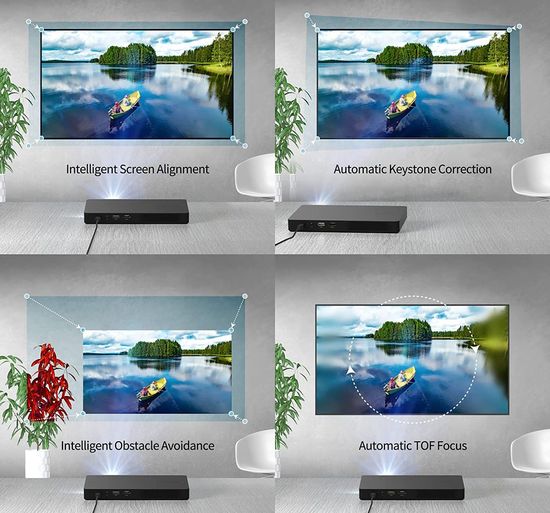
Conclusion
In fact, high brightness raises the price of the model, but increases HDR performance, reduces image size limitations and darkening requirements. Modern UST projectors offer between 2,000 and 4,000 ANSI Lm, which is sufficient for high quality images even in diffuse daylight.
Of course, native 4K resolution provides slightly better image quality. But superb value for money of 4K DLP models with pixel shift gives them dominance in the lower premium segment.
Modern technologies provide superb dynamic contrast due to auto iris and algorithms, significantly reducing the relevance of native contrast.
8-bit color depth is quite sufficient for our vision, which distinguishes about 12 million shades. But it increases the smoothness of color transitions, improving the overall perception of the image.
Prices and specs of some new UST models:
–LG CineBeam HU715Q – $ 3,000, 2,500 ANSI Lm, 4K, 2,000,000:1 dinamic contrast ratio;
–Formovie Theater – $ 3,000 2,800 ANSI Lm; 4K, 3,000:1 (FOFO);
–Epson EpiqVision Ultra LS800 – $ 3,400, 4,000 ANSI Lm; 4K, 2,500,000:1 dinamic contrast ratio;
– Optoma CinemaX D2 – $ 2,300, 3,000 ANSI Lm, 4K, 1,800,000:1 dynamic contrast ratio;
– Hisense PL1 – $ 2,200, 2,100 ANSI Lm, 4K, 2,000,000 dinamic contrast ratio;
– Hisense PX1-Pro and PX1 – $ 2,500 / $ 2,000, 2,200 / 2,000 ANSI Lm, 4K, 1,000,000 dinamic contrast ratio;
–CHIQ B7U ~ $ 2,000, 2,300 ANSI Lm, 4K, 1,500:1 (FOFO).
This video shows lens shift adjustment.
